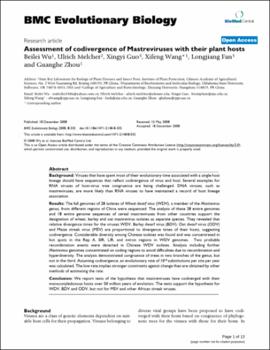| dc.contributor.author | Wu, Beilei | |
| dc.contributor.author | Melcher, Ulrich | |
| dc.contributor.author | Guo, Xingyi | |
| dc.contributor.author | Wang, Xifeng | |
| dc.contributor.author | Fan, Longjiang | |
| dc.contributor.author | Zhou, Guanghe | |
| dc.date.accessioned | 2018-11-09T21:11:00Z | |
| dc.date.available | 2018-11-09T21:11:00Z | |
| dc.date.issued | 2008-12-18 | |
| dc.identifier | oksd_wu_assessmentofcod_2008 | |
| dc.identifier.citation | Wu, B., Melcher, U., Guo, X., Wang, X., Fan, L., & Zhou, G. (2008). Assessment of codivergence of Mastreviruses with their plant hosts. BMC Evolutionary Biology, 8, Article 335. https://doi.org/10.1186/1471-2148-8-335 | |
| dc.identifier.uri | https://hdl.handle.net/11244/302082 | |
| dc.description.abstract | Background: Viruses that have spent most of their evolutionary time associated with a single host lineage should have sequences that reflect codivergence of virus and host. Several examples for RNA viruses of host-virus tree congruence are being challenged. DNA viruses, such as mastreviruses, are more likely than RNA viruses to have maintained a record of host lineage association. | |
| dc.description.abstract | Results: The full genomes of 28 isolates of Wheat dwarf virus (WDV), a member of the Mastrevirus genus, from different regions of China were sequenced. The analysis of these 28 entire genomes and 18 entire genome sequences of cereal mastreviruses from other countries support the designation of wheat, barley and oat mastrevirus isolates as separate species. They revealed that relative divergence times for the viruses WDV, Barley dwarf virus (BDV), Oat dwarf virus (ODV) and Maize streak virus (MSV) are proportional to divergence times of their hosts, suggesting codivergence. Considerable diversity among Chinese isolates was found and was concentrated in hot spots in the Rep A, SIR, LIR, and intron regions in WDV genomes. Two probable recombination events were detected in Chinese WDV isolates. Analysis including further Mastrevirus genomes concentrated on coding regions to avoid difficulties due to recombination and hyperdiversity. The analysis demonstrated congruence of trees in two branches of the genus, but not in the third. Assuming codivergence, an evolutionary rate of 10-8 substitutions per site per year was calculated. The low rate implies stronger constraints against change than are obtained by other methods of estimating the rate. | |
| dc.description.abstract | Conclusion: We report tests of the hypothesis that mastreviruses have codiverged with their monocotyledonous hosts over 50 million years of evolution. The tests support the hypothesis for WDV, BDV and ODV, but not for MSV and other African streak viruses. | |
| dc.format | application/pdf | |
| dc.language | en_US | |
| dc.publisher | BioMed Central | |
| dc.rights | This material has been previously published. In the Oklahoma State University Library's institutional repository this version is made available through the open access principles and the terms of agreement/consent between the author(s) and the publisher. The permission policy on the use, reproduction or distribution of the material falls under fair use for educational, scholarship, and research purposes. Contact Digital Resources and Discovery Services at lib-dls@okstate.edu or 405-744-9161 for further information. | |
| dc.title | Assessment of codivergence of Mastreviruses with their plant hosts | |
| osu.filename | oksd_wu_assessmentofcod_2008.pdf | |
| dc.description.peerreview | Peer reviewed | |
| dc.identifier.doi | 10.1186/1471-2148-8-335 | |
| dc.description.department | Biochemistry and Molecular Biology | |
| dc.type.genre | Article | |
| dc.type.material | Text | |
| dc.subject.keywords | dwarf virus | |
| dc.subject.keywords | tomato yellow leaf | |
| dc.subject.keywords | streak virus | |
| dc.subject.keywords | chinese isolate | |
| dc.subject.keywords | maize streak virus | |
